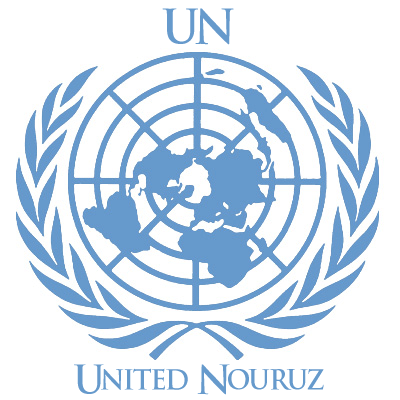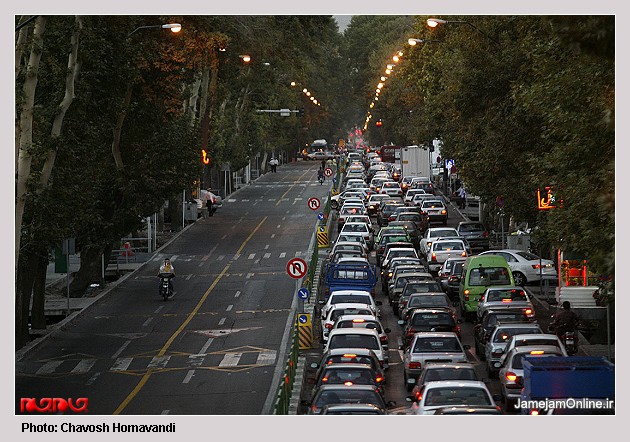
Valiasr Avenue - Tehran
Getting ready for Nouruz, the Persian New Year Celebration, and the coming of Spring is the reason. Nouruz Celebration is one of the oldest traditions of Iranians which its root is from a great glorious civilization that goes back over 3,000 years ago. About more that a quarter of Billion people celebrate the new year and coming of Spring.
One month or more before Nouruz, people prepare themselves by cleaning their house and buying new clothes, nuts and candies, so the intensity of crowd on the streets is conspicuous in Esfand, the last month of Persian Solar Calendar. A black person called Haji Firooz (or Khawja Pirouz), wears red clothes and wanders in the streets in the last days and attracts people by singing, playing and dancing. However, nowadays, you can hardly find them in the streets, at least in the area where I live. It seems that few people are willing to become Haji Firooz.
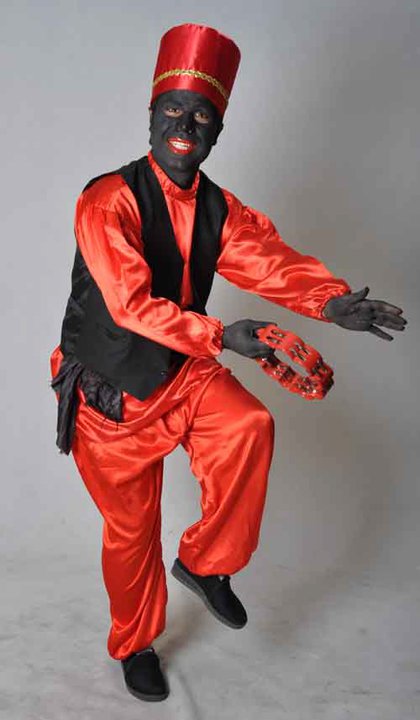 |
| Haji Firooz |
Lord Nouruz has come.
Friends, spread this message -
The New Year has come again!
This spring be your good luck,
The tulip fields be your joy.
Haji Firooz Song
Friends, spread this message -
The New Year has come again!
This spring be your good luck,
The tulip fields be your joy.
Haji Firooz Song
Nowrūz (Persian: نوروز, IPA: [nouˈɾuːz], "New Day", originally "New Light") is the name of the New Year in Iranian calendars and the corresponding traditional celebrations. Nouruz is also widely referred to as the Persian New Year.
Nouruz is celebrated and observed by Iranian peoples and the related cultural continent and has spread in many other parts of the world, including parts of Central Asia, South Asia, Northwestern China, the Crimea and some parts in the Balkans.
Nouruz marks the first day of spring and the beginning of the year in Iranian calendar. It is celebrated on the day of the astronomical vernal equinox, which usually occurs on March 21 or the previous/following day depending on where it is observed. As well as being a Zoroastrian holiday and having significance amongst the Zoroastrian ancestors of modern Iranians, the same time is celebrated in parts of the South Asian sub-continent as the new year. The moment the Sun crosses the celestial equator and equalizes night and day is calculated exactly every year and Iranian families gather together to observe the rituals.
Originally being a Zoroastrian festival, and the holiest of them all, Nouruz is believed to have been invented by Zoroaster himself, although there is no clear date of origin. Since the Achaemenid era the official year has begun with the New Day when the Sun leaves the zodiac of Pisces and enters the zodiacal sign of Aries, signifying the Spring Equinox.
Today, Nouruz tradition is continued through the setting of a special table or spread with an arrangement of specific symbolic items, seven of which have names that start with the Persian letter 'S' (called Sin in Persian). These are:
Sometimes a missing Sin is exchanged with another item starting with an S. For example:
On 13th day so called Nature Day (the National day), people go to the nature and parks for picnic. Usually they take their Sabzeh and release it on a river. An ancient belief says that if girls tie two sprouts of Sabzeh and then release it on a river, soon they will find their love and an appropriate person for getting married with.
Haft Sin
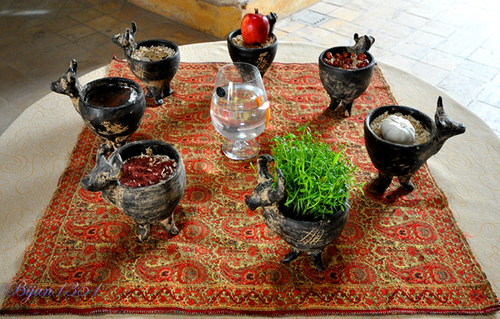 |
| Haft Sin Table |
Today, Nouruz tradition is continued through the setting of a special table or spread with an arrangement of specific symbolic items, seven of which have names that start with the Persian letter 'S' (called Sin in Persian). These are:
- Sabzeh - wheat, barley or lentil sprouts growing in a dish - symbolizing Rebirth
- Samanu - a sweet pudding made from wheat germ - symbolizing Affluence
- Senjed - the dried fruit of the ole-aster tree - symbolizing Love
- Sîr - Garlic - symbolizing Medicine
- Sîb - apples - symbolizing Beauty and Health
- Somagh - sumac berries - symbolizing (the color of) Sunrise
- Serkeh - vinegar - symbolizing Age and Aatience
Sometimes a missing Sin is exchanged with another item starting with an S. For example:
- Sonbol - the fragrant hyacinth flower - symbolizing Spring
- Sekkeh - Coin - symbolizing Prosperity and Wealth
Sizdeh Bedar (13th Outdoors)
On 13th day so called Nature Day (the National day), people go to the nature and parks for picnic. Usually they take their Sabzeh and release it on a river. An ancient belief says that if girls tie two sprouts of Sabzeh and then release it on a river, soon they will find their love and an appropriate person for getting married with.
 |
| Sizdah Bedar , the national day of Nature - People go to the nature and parks for celebrating this day. |
UN Recognition
The UN's General Assembly in 2010 recognized March 21 as the International Day of Nouruz, describing it a Spring festival of Persian origin which has been celebrated for over 3,000 years and calling on world countries to draw on the holiday's rich history to promote peace and goodwill.
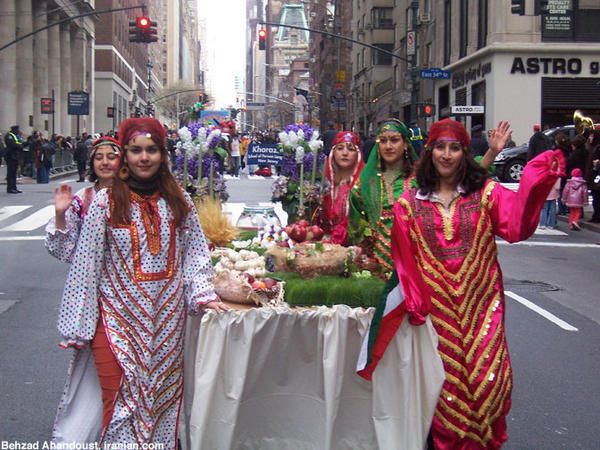 |
| Nouruz Carnival in New York |
Iranians will start the years that are mentioned below:
1) The solar year 7033 (Aryan Civilization)
2) The solar year 6761 (Assyrian Civilization)
3) The solar year 3749 (Zoroastrian Civilization)
4) The solar year 2570 (Achaemenian Civilization)
5) The solar year 1390 (The Civilization since Islam appeared)
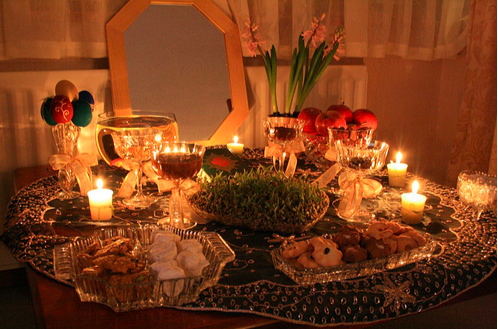
1) The solar year 7033 (Aryan Civilization)
2) The solar year 6761 (Assyrian Civilization)
3) The solar year 3749 (Zoroastrian Civilization)
4) The solar year 2570 (Achaemenian Civilization)
5) The solar year 1390 (The Civilization since Islam appeared)

Iranians will celebrate Nouruz for about 13 days. First day of Spring which is equal with start of Persians New Year and Nouruz, will be on Monday 1st of Farvardin at 02:50:45 (Tehran) or on Sunday, 20th of March at 23:11:30 (GMT).

*.*Happy New Year*.*

It's a culture that people pray each other and ask God for health and happiness in the last moments of the year. So let's pray for people of Japan to be always in peace and no Tsunami happens again in next days and also pray for those who are buried under the dusts to being survived.
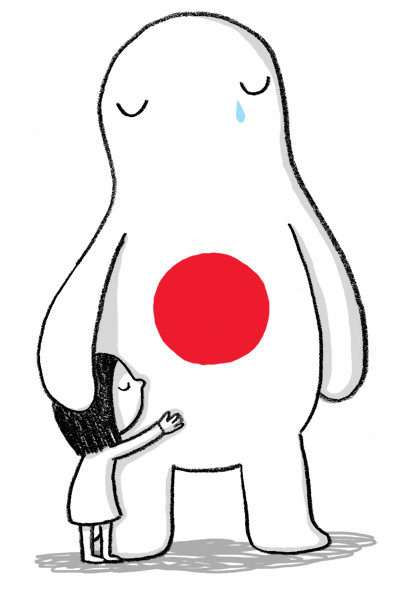
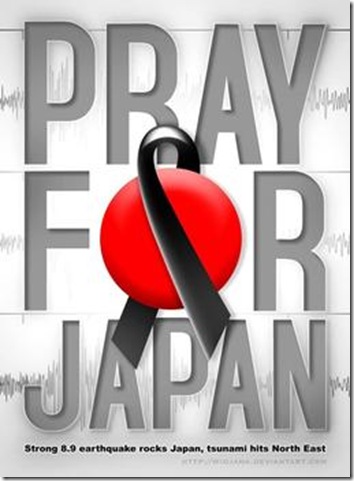
Sources: wikipedia.org, englishcafe.com, chiff.com, iranmap.com, opera.com
